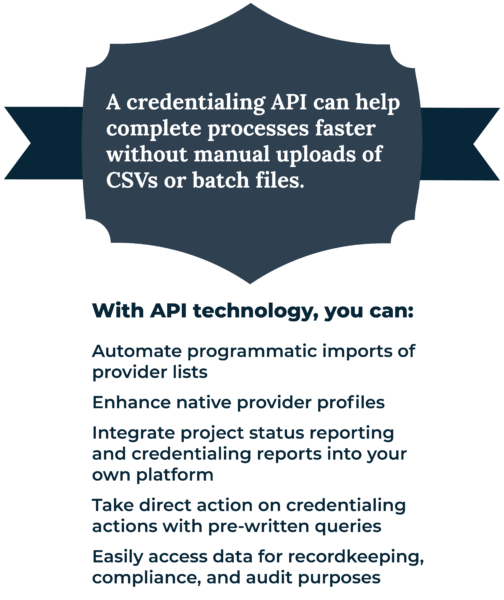Innovation is no longer optional for established health payers and digital native startups. Without revamping inefficient processes, payers risk falling behind in the race for provider participating providers and market share. Here are the first steps payers can take on the path toward sustainable, successful innovation.
The health plan marketplace is evolving quickly as changing demographics, new regulations, and cutting-edge technologies sweep away the status quo. Both commercial health plans and Medicare Advantage (MA) plans are seeing increased competition for visibility and market share, especially as consumers become more and more savvy about their preferences and needs.
But are internal health plan operations innovating at the same rate? Unfortunately for many payers, the answer is “no.”
Even as an emerging class of fresh-faced, digital-first payers and direct-to-consumer (DTC) telehealth companies rises up to challenge the notion of business as usual, a worrying number of payers are still relying on manual processes and fragmented workflows for network development and maintenance. As a result, they are missing out on key opportunities and creating frustration for internal stakeholders and their external partners.
Conventional payers still have plenty of advantages over newcomers to the industry. They have the experience, resources, and history to positively influence provider decision-making. But they must find a way to use their reputations and organizational inertia as an asset instead of a liability.

Technology will be key to success in this area. Payers now have the opportunity to build a springboard for innovation that will reduce administrative burdens and enhance their value proposition among a pool of providers with more choices than ever.
From predictive analytics to APIs, payers can leverage integrated tools and new approaches to solve deeply entrenched problems with recruitment, contracting, credentialing, and compliance.
Whether you’re an established MA plan, a commercial health plan, a telehealth company, or a startup payer looking to gain market share, innovation must become a core competency throughout your organization. Here are the first steps you should be taking along the roadmap to success.
Proactively identify network opportunities in a volatile marketplace
The COVID-19 pandemic has slammed the healthcare industry, prompting tens of thousands of overworked, overwhelmed clinicians to reevaluate their career paths. A mass exodus of qualified physicians, nurses, and other clinical workers will compound predicted shortages, creating a shortfall of close to 200,000 physicians by 2035.
 At the same time, the number of insured individuals is growing. The Affordable Care Act is keeping private insurance accessible, while Medicare Advantage is enjoying continued success among the over-65 population, reaching record enrollment of more than 26 million in 2021.
At the same time, the number of insured individuals is growing. The Affordable Care Act is keeping private insurance accessible, while Medicare Advantage is enjoying continued success among the over-65 population, reaching record enrollment of more than 26 million in 2021.
A market with fewer physicians and more potential members is tough enough for payers looking to develop high-quality networks with adequate coverage. But there’s yet another factor to contend with: the rapid growth of DTC telehealth companies luring top-notch providers away from the traditional care environment.
DTC telehealth startups are exploding onto the scene, capitalizing on a $16 billion opportunity to engage patients in convenient, affordable, consumer-friendly primary care. The benefits are clear for uninsured or underinsured patients – but these companies are also working hard to attract physicians, physician assistants, and nurse practitioners looking for predictable, lower stress, tech-enabled employment.
With the competition for a limited number of providers heating up, established payers, telehealth companies, and other new entrants need to be at the top of their game when developing or expanding their provider networks.
Predictive analytics are essential for helping them get there.
Network development starts by identifying promising markets with appropriate numbers of potential members, and the right mix providers to meet network adequacy requirements. Unfortunately, many payers spend too much time and too many resources exploring territories that end up failing the test.
Predictive market assessment tools can cut down on waste and increase agility by analyzing key data points, such as patterns in provider quality and existing affiliations, to improve their recruiting processes. With access to such relevant and timely data, network develop teams can make smart, informed decisions about when and where to focus their efforts.
Better information and speedier action translate into the ability to beat out competition while getting ahead of administrative requirements and regulatory paperwork.
Ask yourself:
- Do I have clear insights into my internal capacity to enter a new territory? Am I starting early enough to reallocate resources if necessary?
- Do I understand the existing business dynamics in that territory, including existing provider relationships and the influences of competing plans?
- Can I quickly and accurately identify top candidates for my network based on trustworthy performance data?
- Do I have real-time visibility into the contracting process so my staff can follow up immediately on missing documents when necessary?
- Can I achieve – and maintain – network adequacy if my first-choice providers fall through? How quickly can I pivot so I can stay in compliance?
Offer best-in-class contracting and credentialing experiences with data-driven tools
Strong competition for fewer high performing providers means payers aren’t necessarily in the same position they were a few years ago. When providers start to realize that they can get choosier about the terms they accept, payers will have to use different tactics to court clinicians.
 Better relationships and experiences between providers and payers will be a key part of securing favorable contracts. Payers can start by mirroring the consumer-friendly strategies they are already using to satisfy their beneficiaries, like leveraging application programming interfaces (APIs) to grant access to more data more quickly.
Better relationships and experiences between providers and payers will be a key part of securing favorable contracts. Payers can start by mirroring the consumer-friendly strategies they are already using to satisfy their beneficiaries, like leveraging application programming interfaces (APIs) to grant access to more data more quickly.
These standardized bridges between disparate data sources have quickly become crucial for giving beneficiaries streamlined, one-click access to quality and cost data, network directories, and personal health information.
Providers want exactly the same simplified workflows and communications when it comes to their own interactions with health plans. Incorporating APIs into contracting and credentialing can dramatically simplify a process that normally takes weeks or months of back-and-forth phone calls, emails, and faxes. Automating cumbersome tasks can eliminate errors while offering more control and flexibility to both provider office staff and payer credentialing teams.
The ubiquity of APIs in consumer technology makes it strange to think that at the moment, APIs are rarely found in this arena. For many years, the industry hasn’t been ready to embrace API technology, despite its success in every other facet of digital life.
 That reluctance is finally wearing off as traditional payers start to reexamine their legacy infrastructure and reinvent their tech stacks. APIs will need to take pride of place in those new data-driven designs, especially for payers that hope to outperform their peers in the evolving landscape.
That reluctance is finally wearing off as traditional payers start to reexamine their legacy infrastructure and reinvent their tech stacks. APIs will need to take pride of place in those new data-driven designs, especially for payers that hope to outperform their peers in the evolving landscape.
Credentialing is an ideal entry point for enterprises that are still uncertain about the role of APIs. Embedding API-driven technology into the credentialing workflow, for example, can eliminate the need for tedious, error-prone batch processing or CSV uploads, thereby reducing turnaround time while giving providers the digitally native interactions they have come to expect from leaders in the field.
Ask yourself:
- What does my current credentialing process look like? Do I have the tools I need to make proactive decisions? If not, what would my ideal future state look like?
- Can I easily access verified, up-to-date data from local, state, federal, and private institutions to aid with credentialing?
- Am I using industry-leading credentialing criteria, such as NCQA’s credentialing accreditation requirements? If not, is it time to adopt this recognized standard of quality?
- Are there opportunities to automate or outsource inefficient, manual processes that often lead to errors? Are APIs and self-serve provider portals a good fit for my organization’s needs?
Craft an integrated technology (and process) platform focused on value
With a slew of new companies changing the game with a blank-slate perspective on healthcare, MA plans simply cannot afford to continue relying on piecemeal technologies and scattershot processes.
Identifying and addressing inefficiencies in current strategies for recruiting, contracting, and credentialing is the perfect place to start – but it’s only the beginning. Plans need to think bigger by reimagining their potential for success and building a comprehensive technology ecosystem that links previously disparate processes together in a seamless, intuitive manner.
For example, consider viewing contracting and credentialing as a continuum rather than separate steps to be handled sequentially.
 Instead of wasting weeks or months on contracting with a provider who ends up not being qualified for inclusion in the network, begin credentialing concurrently. Not only will this save time in the long run, but it can also give you sharper, speedier insights into the likelihood of reaching network adequacy when and where you need it.
Instead of wasting weeks or months on contracting with a provider who ends up not being qualified for inclusion in the network, begin credentialing concurrently. Not only will this save time in the long run, but it can also give you sharper, speedier insights into the likelihood of reaching network adequacy when and where you need it.
As you re-envision your workflows, think about working with a technology provider who can give you access to rich, verified provider data and robust credentialing reports – and embed these capabilities directly within the platforms you’re used to working with.
And don’t forget that network development doesn’t stop there. Contract management, recredentialing, and regulatory compliance are constant concerns with year-round timelines. Staying on top of these requirements involves cross-team collaboration and seamless access to data. Artificial organizational barriers can create gaps in communication that lead to missed deadlines and extra paperwork.
Most organizations won’t be able to rip and replace their entire network development infrastructure all at once. They won’t be able to change everything about their processes in an instant – and that’s understandable. But as you think about what your future state could be, keep the idea of an integrated, seamless technology ecosystem in mind.
Work with solutions providers who offer standards-based products that can fit together to augment and enhance your core platform. And continue to involve expert staff members from your organization and your provider partners to learn about the everyday challenges that need to be solved.
Ask yourself:
- Are my internal communication and handoff strategies helping or hurting the network development process?
- Have I collected thorough, honest, and open feedback from my staff members about what workflows could be improved? Have I done the same with provider office staff to incorporate their needs and viewpoints?
- Do I understand what technologies are available to help overcome these pain points? Do I need help from a knowledgeable partner to implement new tools and design effective strategies?
- Am I building a data-rich environment that leverages shared standards and interoperable tools to future-proof my organization?
- How am I measuring the success of new initiatives? How am I sharing these insights across the organization to foster continuous learning?
In conclusion
Competing in the high-pressure payer environment isn’t easy. Traditional health plans and newer players are all jostling for mind share while contending with a shrinking supply of high-quality providers.
Agility and creativity will be crucial for success in this evolving marketplace. When innovative workflows combine with cutting-edge technology, health plans will have the tools and strategies they need to get ahead of the competition.
Getting started with generating meaningful, sustainable change is a daunting prospect. But it’s also an imperative. The right tech tools and techniques can create a platform upon which to build lasting transformation. With seamless processes and integrated technologies opening up so many opportunities, forward-thinking organizations can improve experiences, reduce unnecessary burdens, and meet their long-term clinical and financial goals.



